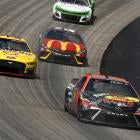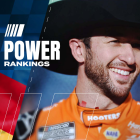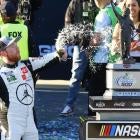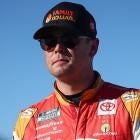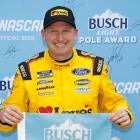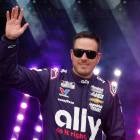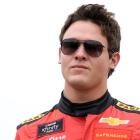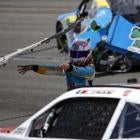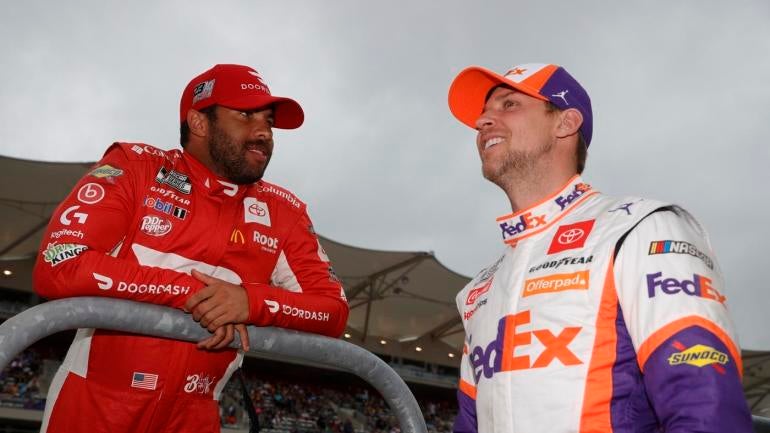
After putting together one of NASCAR's great careers over the last 15 years, Denny Hamlin began his 16th Cup Series season by adding a new credential to his esteemed racing profile. At 40 and still very much in his prime as a driver, Hamlin has put himself at the forefront of a new generation of forward-thinking NASCAR car owners.
Joining forces with personal friend and business partner Michael Jordan, Hamlin formed 23XI Racing for 2021, fielding the most prominent of three new Cup Series teams and overseeing a launch that was highly-publicized well before the team's No. 23 Toyota rolled off the hauler for the first time in Daytona.
Months after its arrival was heralded, 23XI Racing has settled into its place in the middle class of the Cup Series, and Hamlin has settled into the role of overseeing the team's short and long-term growth. Despite leading 46 laps this season, 23XI has yet to score a Top 10 finish, seemingly hitting their ceiling around 11th-20th in the running order -- which wasn't outside of the expectations that Hamlin had for driver Bubba Wallace and crew chief Mike Wheeler.
"I think that they're on a good progression. Early on in the year they were running somewhere between 16th-20th. I think that that's definitely gotten much lower, three to five spots as the year has gone on," Hamlin told CBS Sports. "We actually haven't reached half a portion of the year quite yet, so I think that we're pretty close to where I thought that we would be. But that should get progressively better as the year goes on. So overall, they've met expectations thus far."
Although the reality of fielding a first-year race team has made itself apparent, 23XI Racing's vision for the future -- and the idea of its immediate growth -- has not been tempered. In an interview with the Air Jordan brand, Hamlin said that he has a goal of expanding 23XI to be a multi-car team. And that expansion may soon be on the horizon, as a recent report by Jordan Bianchi of The Athletic stated that 23XI would expand to two cars in 2022 -- with veteran Kurt Busch the leading candidate to join the team.
However, adding to a race team has never been a simple proposition, especially in a sport where even the best-laid plans are wholly contingent on dollars and cents. And complicating matters is NASCAR's move to a franchising model in the Cup Series, which offers "charters" to 36 cars that guarantee them a spot in each race -- the acquisition of which has become a major hurdle to teams seeking to enter NASCAR's top level and be competitive within it.
"I think that we're still actively looking. We haven't really committed any bids or anything like that thus far. It's more just kind of talks with some of these teams that are prospective sellers," Hamlin said of potential expansion. "I think really, it just kind of depends on whether it economically makes sense to us - The whole charter market -- and whether it's the right time for us to go to two cars, we'll see.
"But ultimately, yeah, we would like to have two charters to have a guaranteed spot in the field, to have increased revenue. But ultimately you have to look at the dollars and cents of it to figure out whether you can make that investment work over a period of time."
Introduced in 2016 after NASCAR's car owners organized to form the Race Team Alliance, a de facto union to promote their interests, the charter model exists in order to give full-time teams a tangible asset which guarantees them a place in the field while also giving them something to sell off for millions in the event they leave the sport.
However, franchising in NASCAR has been far from perfect thanks to the existence of multi-car teams, as well as certain actors within the system.
As opposed to other sports, where each team owner owns one franchise, 19 of NASCAR's 36 charters are split between five teams: Hendrick Motorsports, Joe Gibbs Racing, Stewart-Haas Racing, and Rick Ware Racing all field four cars each, while Team Penske fields three. That leaves just 15 for the rest of the field, many of which belong to various two-car teams. While a charter is not a requirement to field a Cup Series car, the prize pool for non-chartered cars is significantly less, and such cars must qualify for races on speed if more than 40 cars enter a Cup race -- presenting the dreaded danger of failing to qualify if something goes wrong or they aren't fast enough.
While the top teams can spare no expense in competing for wins and championships, there are other chartered teams that operate on tight budgets and are simply looking to be as competitive as they can while also surviving. And then, there's other chartered teams that operate a business model which allows them to generate a profit, but also means that they're cheaply run and field non-competitive cars (Rick Ware Racing, which fields backmarker cars, has been criticized as such given the amount of charters they own).
"I just think that it's a different model for everyone, and everyone has an agenda. And it's just trying to figure out how a new team that wants to win legitimately gets into the sport without costing an arm and a leg," Hamlin said. "That's a little bit of a challenge that there is right now. Right now I know that us and Trackhouse (Racing) and I'm sure someone else is out there trying to field a good, competitive team.
"We have to be smart with the money side of things and make sure that we're making good financial, sound decisions. And if we have to run without a charter, then we have to run without a charter. We can use that money to help develop other things to make us run better."
Presently, NASCAR's current charter model runs through 2024, so reforms to the system are unlikely untilthen. But with more teams looking to acquire charters and enter the Cup Series than in years' past -- Xfinity Series powerhouse Kaulig Racing, for instance, intends to field a full-time Cup team in 2022 -- Hamlin anticipates that the amount of available charters may soon open up as teams are forced to adapt to the introduction of NASCAR's Next Gen car, as well as other circumstances.
"There's some rules on NASCAR's side that they can enforce that will make it tougher for some of these teams that have a bunch of charters to sustain their current business model, and I also think that this new car is gonna be a little bit of a significant upgrade in costs for the first couple years as well," Hamlin said. "So that probably will weed out a few teams as well."
While Hamlin charts a course for 23XI Racing as a car owner, he has his own challenges to contend with as a driver for Joe Gibbs Racing. After winning seven times in 2020, Hamlin has yet to visit Victory Lane in 2021, with the domination of the Hendrick cars currently barring his way.
Entering this weekend in Nashville, Hamlin currently leads the Cup Series points standings, but his lead has shrunk to 47 points over a hard-charging Kyle Larson. And while a new racetrack in Nashville Superspeedway presents a blank slate for the Cup Series field, Hamlin believes that Hendrick's current advantage won't be muted by any means.
"You have to have high downforce and a lot of horsepower, and that's what those cars are killing everyone at right now is that they've got the latest and greatest body that's been built," Hamlin said. "It took them awhile to tune it in, but they've got it tuned in now and it's part of the rules.
"They've got the latest body that they were able to design around this high-drag package, and now they're sharing information on the engine side with ECR, so they've gotten some good engine upgrades. And so we're all playing catchup right now because of it."
While 23XI Racing's best finish this season has been an 11th at Dover, Hamlin has had nine Top 5s and 12 Top 10s through 16 races so far, with a best finish of 2nd at Richmond.














